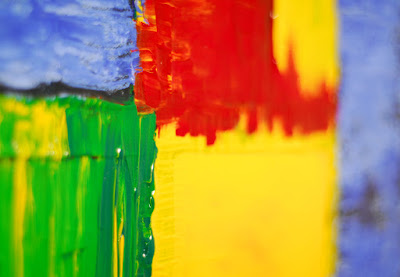
We avoided this left part of the slope and instead went along the ridge line, only cruising around the last few rocks in the shade. At the time when we sailed down there I thought: what's the difference - why is this route safe while there's avalanches right next to it? And if it's not safe - why not just go for the avalanche terrain - aside from the avalanches it looked even sweeter (a little steeper) and had some tracks, actually. After the training, these choices are far more intuitive to me: First, the ridge line is lower angle, so snow is less likely to slide. Next, we stayed high in the start zones of avalanche paths or even above the start zones so even if they did start we would not get caught in the middle. Finally, even though the lines we took did eventually steepen and traverse around some rocks (whoohoo!), due to the different aspect, the snow had much less sun exposure there which means it was more stable than the adjacent slope in the left part of the picture. Furthermore, the rocks in the slope on the left would act as trigger points for avalanches if we were to sail down there, because with the sunshine they puncture and therefore destabilize the snow. Of course, given how many rocks we can see on this slope it is likely that there will be more hidden rocks, covered by some snow that the wind blew over them. Not that I'm claiming this analysis is perfect, but I sure feel more knowledgeable about this now than I did before.
So, here is Geoff Clarke, our Avy I instructor explaining how to dig a snowpit, how to measure the angle of the slope, and how to carry out a compression test. These procedures are a bit of a drag but they help with understanding the avalanche danger on a particular slope, which hopefully lets us make better decisions about where we're riding and which line we end up taking. Geoff made even this informative session entertaining and therefore easy to follow - more than once he suggested (perhaps jokingly?) that we'd "build a kicker"... He is someone who finds a reasonably safe route through potential avalanche terrain every day while having plenty of fun, and he shared both his wisdom and some of the fun with us.

So, here comes the fun: the Saturday session involved "earning" a run in the backcountry. This was the first time I've used a splitboard. On the way up, the board splits into two skis to which I attached climbing skins. The skins are made out of magic material that sticks to the skis, and makes it so they only slide forward, that is, up the hill. As far as climbing up the hill goes, as the only snowboarder in the group I didn't see any disadvantage compared to others. Certainly my heart rate went up a little bit but that's to be expected when you're skiing uphill. On the way down, you put the skis back together and it's a real snowboard! Overall I was surprised how well it worked. It felt a tiny bit too stiff and weird when making a turn on packed snow (we did a couple warmup runs on groomers) and it was harder to take the nasty traverse from the Cornice lift toward Palisades on my heel edge (perhaps because the Voile system adds extra space between boots and board - the regular bindings slide onto metal rails), but for the backcountry powder there was no significant difference to my regular board - I'd say it turns and floats equally well. The main downside compared to backcountry skis appears to be the time it takes to convert between climbing mode (split apart) and snowboard mode (put together), because one needs to remove all snow and ice from the inner edges and the rails onto which the snowboard bindings slide. Perhaps it's not a silver bullet, but for a snowboarder a splitboard still seems like the ticket to the vast majority of fresh terrain that cannot be accessed via lifts. Sweet.












